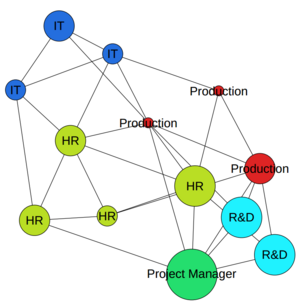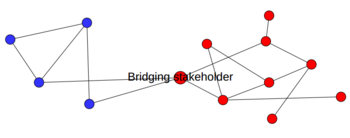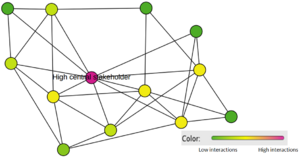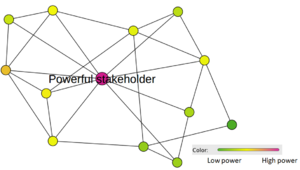Stakeholders from a dynamic and network perspective
NobodyKnows (Talk | contribs) (→What is missing in the current practices of a stakeholder analysis) |
NobodyKnows (Talk | contribs) (→Conclusion) |
||
| Line 98: | Line 98: | ||
= Conclusion = | = Conclusion = | ||
| − | By implementing a more in-depth quantitative SNT into the current qualitative stakeholder | + | By implementing a more in-depth quantitative SNT into the current qualitative stakeholder analysis will provide a stronger framework for identifying crucial stakeholders for focusing attention and for how to catagories the most relevant stakeholders. It will help PMs for identifying not only the formal power structure within the project, but also how the informal power also can influence the succes of the project. Applying the presented algorithms will give an overview for the more active and communicative stakeholders in the network. |
| − | + | Possible downsides for combing these methods is that it can be a more costly and time consuming process, compared to e.g. conducted large focus groups. | |
| − | + | ||
= References = | = References = | ||
<References/> | <References/> | ||
Revision as of 21:16, 27 November 2014
Contents |
TODO
- Skriv noget om det christian har forelæst om.
- Antifragily or not
Abstract
Conducting a traditional stakeholder analysis gives the investigator a current state of the analysed scenario. This type of analysis works as a macro analysis, not only framed to contain a specific area of investigation, but takes into account all the different kind of actors (person, group or organisation) that currently has an interest and that can affect, or be affected by, the give action/project.
This article takes the perspective that conducting a stakeholder analysis has to be an iterative process, due to the fact as when a project progress the power and interest of the mapped stakeholders can change drastically. This needs to be taken into account, when “managing” these stakeholders. Therefore taken a more dynamically approach towards stakeholder analyses will help the investigator(s) conducting them.
Typically, when conducting stakeholder analyses mainly two types of dimensions are considered, when mapping them; these could be power vs. interest or Interest vs. Influence. Inspired by analytic tools such as bubble diagrams for project prioritisation and network theory for social networks, which both assign values to the actual nodes (stakeholders) used in the diagram. This could be relevant for the investigator to able to look into these, by adding values himself or through questionnaires. Suggested “node values” could be “knowledge of the project”, “seniority”, “involvement of the project” and their own opinion regarding their “attitude towards the project”.
Applying network theory for mapping stakeholders by e.g. how they communicate, a “shadow network” can emerge. This can represent the informal structure of the organisation, where the project is being implemented. Looking into shadow networks, multiple applications can emerge. One application could be for when influencing different, but the right, stakeholders. It can be more effective by persuading an already enforcer of the project and then use that stakeholder for affecting other key stakeholders, which potential support is needed. Selecting the right enforcer could be analysed from the way stakeholders are interlinked and through the “amount” of communication between them. This can be done in practise by assigning a specific value to the communication between the stakeholders, which then can be illustrated through the edges between them.
Taking into account for creating a more dynamic tool, regarding stakeholder analyses, shadow networks can also be used for predicting, how future scenarios could look like. If crucial stakeholders primarily are surrounded by stakeholders that are negative towards the project – actions needs to be taken – although that specific stakeholder’s attitude towards the project currently is positive.
As all models are not universal, this approach would also have restrictions, where one crucial disadvantage is that stakeholders from the environment could potentially be less represented in the analysis, compared to more internal stakeholders.
Overview of a Stakeholder Analysis today
Conducting a stakeholder analysis is done with the purpose of getting an overview of different actors that currently has an interest and that can affect, or be affected by, a give action/project. This will be useful during project, due to the fact it will be possible to get an understanding on how much attention different stakeholders should get. When using the term “stakeholder”, it covers a broad range of actors; such as individuals, groups and organisations. A stakeholder analysis is what can be characterised as a macro analysis because it not only takes into account for the organisation or a specific area of investigation, but also takes into account for the external environment. From this the analysis can be broaden to take multiple levels into consideration, which includes local, regional, national and even international [2.340]. This will affect the researcher and how this person will have to collect the necessary information.
Conducting a “local stakeholder analysis” usually means that the stakeholders are reachable for individual interviews and otherwise the analysis has to use other kind of existing documentation, such as e.g. reports, if interviews are not a possibility.
The purpose for conducting this kind of analysis is to get a more in depth understanding about the involved stakeholders and their interest, intentions, agendas and their influence or potential resources the project could benefit/dis-benefit from [1, p.241]. From this it can be relevant for distinguish between stakeholders by categorising them as primary (crucial for the survival of the project) and secondary (important, but not essential for the survival) stakeholders [1, p.423].
Current practices, when conducting a Stakeholder Analysis
Multiple kinds of stakeholder analyses can be found in the literature [2][3], depending on what kind of aspects is considered most important. Usually the models all have in common that they are grid based, usually in a two dimensional matrix tables, where this e.g. can represent power vs. Interest, see figure XYZ. Colleting the necessary information can be divided into two subgroups; primary and secondary data gathering [2, p.341].
Primary data gathering cover interactions between stakeholders and researcher, which includes different kind of interviews including semi-structured, structured etc., but also the use of focus groups. The secondary data gathering is more data oriented e.g. reports, internal documentation and is usually discovered during the semi-structured interviews [2]. Current practices concerning stakeholder analyses are primarily based on primary data gathering [4, p.134], where it is investigated “who is important” and “who will be affected” [4,p.146]. From this perspective it can be concluded that this form of a stakeholder analysis, is based on more qualitatively data.
What is missing in the current practices of stakeholder analyses
Even though a lot of the literature states, when conducting a stakeholder analysis it is crucial it is done from a dynamic and iterative perspective [REF], very little actually states how to do this in practice. This reason for this is due to the fact that as a project progress existing stakeholders may change attitude towards the project and also, new stakeholders may emerge, which needs to be taken into consideration. From this a stakeholder analysis has to be a more dynamic tool and taking into account how the stakeholders actually are interconnected.
Knowing how stakeholders are interconnected can also help researcher to better forecast on the future, regarding stakeholders’ potential behaviour. Therefore current stakeholder analyses needs to be expanded to take into account for more quantitative data gathering, through e.g. questionnaires [4,p.134]. Getting an overview of how stakeholders are interacting can further help for investigating the shadow network, which is the way stakeholders are interconnected and not from the perspective of the organisational diagram [5]. This can help to get a better understanding of the power structure between the stakeholders, especially due to the fact that a traditional stakeholder analysis does not always take into account for the informal power aspect.
Applying Social Network Theory aspects into a stakeholder analysis
As mentioned earlier, a stakeholder analysis is primarily based on a qualitatively approach for how to identify relevant stakeholders from both a present and a future perspective. During projects multiple stakeholders can at some point show some sort of interest, which either can be positive or negative. This is crucial for project managers, having an idea of for what to anticipate and then how to accommodate this before it is too late. Applying social network theory (SNT) into a stakeholder analysis implies that not only are the individual stakeholders important, but also the way they are interacting, is also important.
The reason why the interaction of stakeholders are relevant for investigating is due to the fact that stakeholders with strong ties are more likely to being able to influence each other [6.p.503]. This kind of influence can be either positive or negative because it can indirectly also illustrate trust, respect, communication, support etc., which all can have crucial impact of the success of getting the maximal benefit of the identified stakeholders. SNT can therefore help to discover informal power structures between stakeholders, where as formal power usually can be extracted by looking directly into the organisational diagram. The procedure for investigating power structures (looking into power, influence and interest) are explored in section " Size of nodes and edges".
Applying Social Network Theory
The most efficient way for gathering the relevant kind of data would be through questionnaires, which will in a higher degree ensure more quantitative data that through SNT can be analysed. There exists many different SNT programs, such as UNICET and GEPHI, where most automatically already has incorporated a various portfolio of different mathematical algorithms, which can be used for analysing the data. Combining a stakeholder analysis and SNT, primarily two types of networks can be of great importance for being able to detect, and will be described further down through the article [5.p65):
- Cohesive Networks,
- Bridging Networks
Size of nodes and edges
By applying SNT, stakeholders can be given several different attributes, either assigned by themselves or by stakeholders. These different values (based on a scale) can be illustrated through the size of the nodes for detecting potential risk or opportunities that the researcher otherwise would not have realised. A list for different attributes can be seen below [4,p.137]:
- Themselves: Age, knowledge of the project, seniority, Attitude towards the project, interest, influence, power, involvement of the project, who they are communicating with etc..
- Assigned by others: Attitude towards the project, interest, influence, power etc..
In figure XYZ an example has been created for illustrating how a network could like, where the node size represent the “Attitude towards the project”. From figure XYZ it could be argued that the project manager (PM) has not spend enough time promoting the project for the IT- and Production department, due to the fact that their attitude is quite low compared to the stakeholders closer to the PM. From this an obvious solution would for the PM to reach out to the departments, open-minded, and investigating the reason for the low attitude. Another argument why it is relevant to reach out is because one of the IT employees actually has a high positive attitude, but he is more or less only interconnected with his own department. Taking into a time/ risk perspective he could potentially overtime change his opinion.
Betweenness Centrality
The type of network illustrated in figure YYY can be characterised as a bridging network [5, p.65]. Being aware of this kind of network can be very beneficial for a PM during projects. Stakeholders identified in the center of bridging networks are also called gatekeepers/brokers [4,p.138], which can help the PM in numerous ways. Using gatekeepers can help the PM controlling the type of information and the flow of what should be directed where. This type of stakeholder will usually have strong ties with his interconnected stakeholders, which is very common, due to the fact that as more interactions a stakeholder have, the weaker they will become. Therefore a good starting point for a project would be for the PM to get the gatekeepers support so they can act as ambassadors throughout their network, when communicating the project.
This type of network is a good example of how e.g. stakeholders with low formal power actually still can have a strong influence by his informal power, due to the fact that without this stakeholder the whole network would otherwise decay and consequences of this could damaging to the success of the project.
The algorithm calculating the betweenness centrality in nodes, are based on counting how many times a stakeholder is the path between two stakeholders that are not directly interconnected (acting as the bridge) [4].
Degree Centrality
From figure ZZZ a network has been created, which illustrates what can be defined as a cohesive network [5,p.65]. This type of network emerges, when interactions between many stakeholders exist and especially one or few are highly interlinked. These stakeholders can also be stated to have a high degree of centrality. From figure ZZZ a visual illustration shows that the algorithm can colour the different from the way they are interconnected, where the “pink” stakeholder will be the person with highest degree of centrality.
Overall can this type of network be very important to identify, because usually there will be a lot of trust and the central stakeholders can help to bring the network together towards a project, due to their internal relations. This can again be related back to what is called informal power. It can therefore be a good suggestion for a PM to approach this stakeholder and create an alliance instead of approaching every single stakeholder himself. As a project progresses these interrelations will probably change and it is therefore important that the PM updates the network and spends time analysing them for investigating possible trends of interrelations.
This type of algorithm is quite simple structured, due the fact that it works by counting the edges for every single node, and from that it is possible to either colour grade, or alter the sizes of, the nodes [4].
Eigenvector Centrality MÅSKE SLETTE
- Used for mapping power within a network.
- Stakeholders identified needs to be invistagted - is it formal or informal power.
Conclusion
By implementing a more in-depth quantitative SNT into the current qualitative stakeholder analysis will provide a stronger framework for identifying crucial stakeholders for focusing attention and for how to catagories the most relevant stakeholders. It will help PMs for identifying not only the formal power structure within the project, but also how the informal power also can influence the succes of the project. Applying the presented algorithms will give an overview for the more active and communicative stakeholders in the network.
Possible downsides for combing these methods is that it can be a more costly and time consuming process, compared to e.g. conducted large focus groups.



